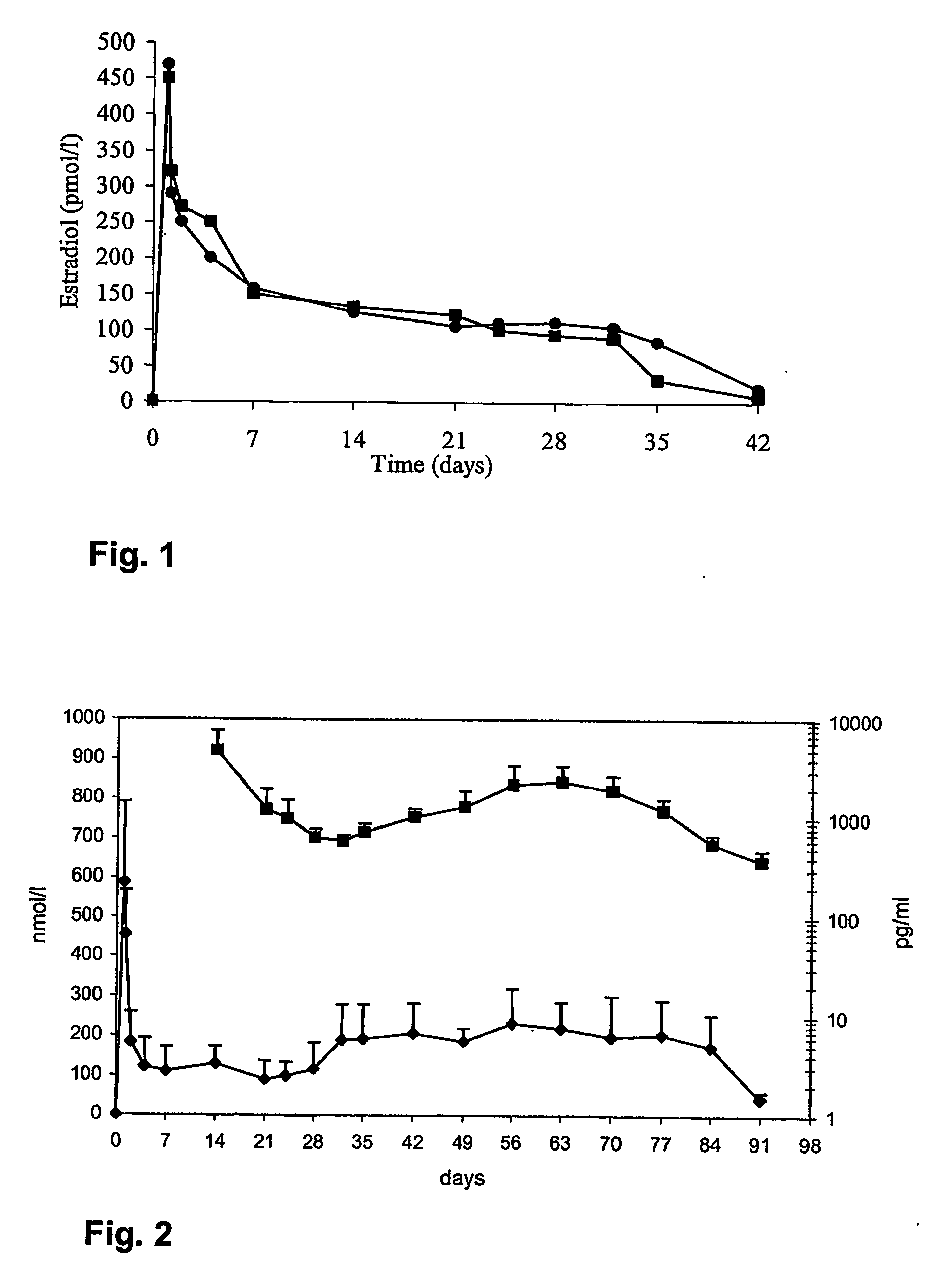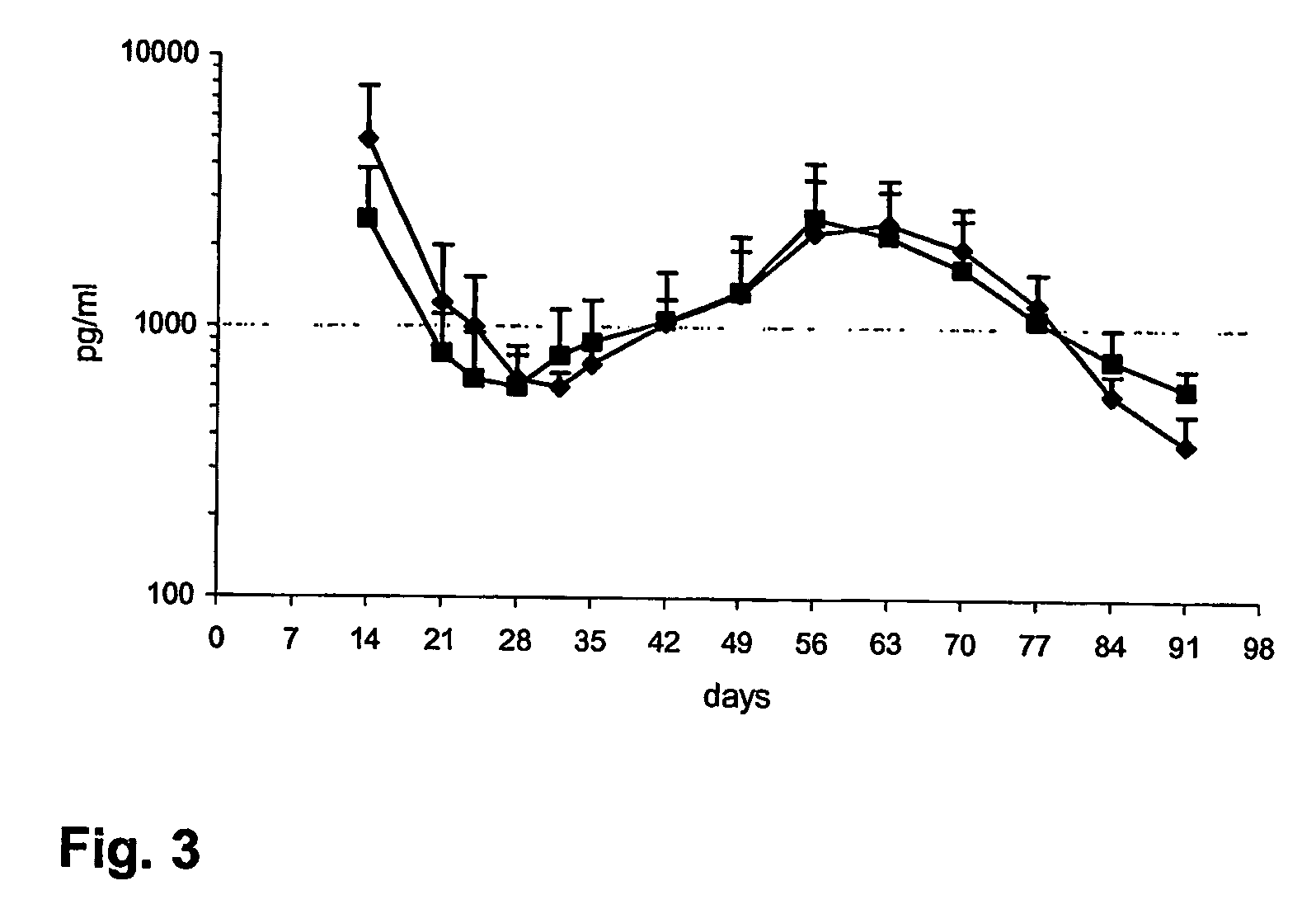Methods and compositions using gonadotropin hormone releasing hormone
a technology of gonadotropin and releasing hormone, which is applied in the direction of drug compositions, peptide/protein ingredients, metabolic disorders, etc., can solve the problems of increased risk of cardiovascular complications, so as to reduce the enhanced loss of bone mineral density
- Summary
- Abstract
- Description
- Claims
- Application Information
AI Technical Summary
Benefits of technology
Problems solved by technology
Method used
Image
Examples
example 1
Preparation of a Composition Releasing Triptorelin and Estradiol Over a Period of at Least One Month
1. Formulation of Triptorelin
[0037] This formulation was obtained according to the method described in U.S. Pat. No. 5,134,122, Example 1.
2. Formulation of Estradiol Embedded into PLGA Microspheres
[0038] An aqueous phase (Solution A) was prepared by mixing under magnetic agitation 160 g of PVA (polyvinyl alcohol) and 7840 g H2O MilliQ at a temperature of 40° C. Next, an organic phase (Solution B) was prepared by dissolving 4.9 g of polymer 50:50 poly (D,L-lactide-co-glycolide) (inherent viscosity (iv)=0.42 dl / g) in 50 g of ethyl acetate under magnetic agitation. 100 mg of estradiol were dissolved in 800 μl of DMSO (solution C).
[0039] Solutions B and C were mixed together and the obtained solution was pumped into the homogenisation chamber at a rate of 5 ml / minute. Solution A was pumped in parallel at a rate of 750 ml / minute into the homogenisation chamber. The rotation speed of...
example 2
Preparation of a Composition Releasing Triptorelin and Estradiol Over a Period of at least one month
1. Formulation of Triptorelin
[0042] This formulation was obtained according to the method described in U.S. Pat. No. 5,134,122, Example 1.
2. Formulation of Estradiol Embedded into PLGA Microspheres
[0043] An aqueous phase (Solution A) was prepared by mixing under magnetic agitation 80 g of PVA (polyvinyl alcohol) and 3920 g H2O MilliQ at a temperature of 40° C. Next, the organic phase (Solution B) was prepared by dissolving 4.5 g of polymer poly 65:35 poly (D,L-lactide-co-glycolide) (inherent viscosity (iv)=0.62 dl / g) in 25 g of ethyl acetate under magnetic agitation. 92 mg of estradiol were dissolved in 800 μl of DMSO (solution C).
[0044] Solutions B and C were mixed and this solution was pumped into the homogenization chamber at a rate of 5 ml / minute. Solution A was pumped in parallel at a rate of 630 ml / minute into the homogenization chamber. The rotation speed of the rotor is...
example 3
Preparation of a Composition Releasing Triptorelin and Estradiol Over a Period of at Least Three Months
1. Formulation of Triptorelin
[0047] A formulation of microgranules of triptoreline pamoate was prepared according to the following method.
[0048] Approximately 12 wt % of triptoreline pamoate was mixed with approximately 88 wt % PLGA 75:25 in a ball mill, at room temperature. The given mixture was duly homogenized, subjected to a progressive compression and simultaneously to a progressive heating, before extruded at a temperature of approximately 110° C. The extrudate was cut into pellets and ground at a temperature of about −100° C. The microgranules obtained after grinding were sieved below 180 microns.
2. Formulation of Estradiol
[0049] A formulation of microspheres of estradiol and PLGA 50 / 50 having an inherent viscosity of 0.42 dL / g (formulation 1) was prepared as follows:
[0050] The aqueous phase (Solution A) was prepared by mixing under magnetic agitation 160 g of PVA (p...
PUM
| Property | Measurement | Unit |
|---|---|---|
| bone mineral density | aaaaa | aaaaa |
| temperature | aaaaa | aaaaa |
| temperature | aaaaa | aaaaa |
Abstract
Description
Claims
Application Information
 Login to View More
Login to View More - R&D
- Intellectual Property
- Life Sciences
- Materials
- Tech Scout
- Unparalleled Data Quality
- Higher Quality Content
- 60% Fewer Hallucinations
Browse by: Latest US Patents, China's latest patents, Technical Efficacy Thesaurus, Application Domain, Technology Topic, Popular Technical Reports.
© 2025 PatSnap. All rights reserved.Legal|Privacy policy|Modern Slavery Act Transparency Statement|Sitemap|About US| Contact US: help@patsnap.com


